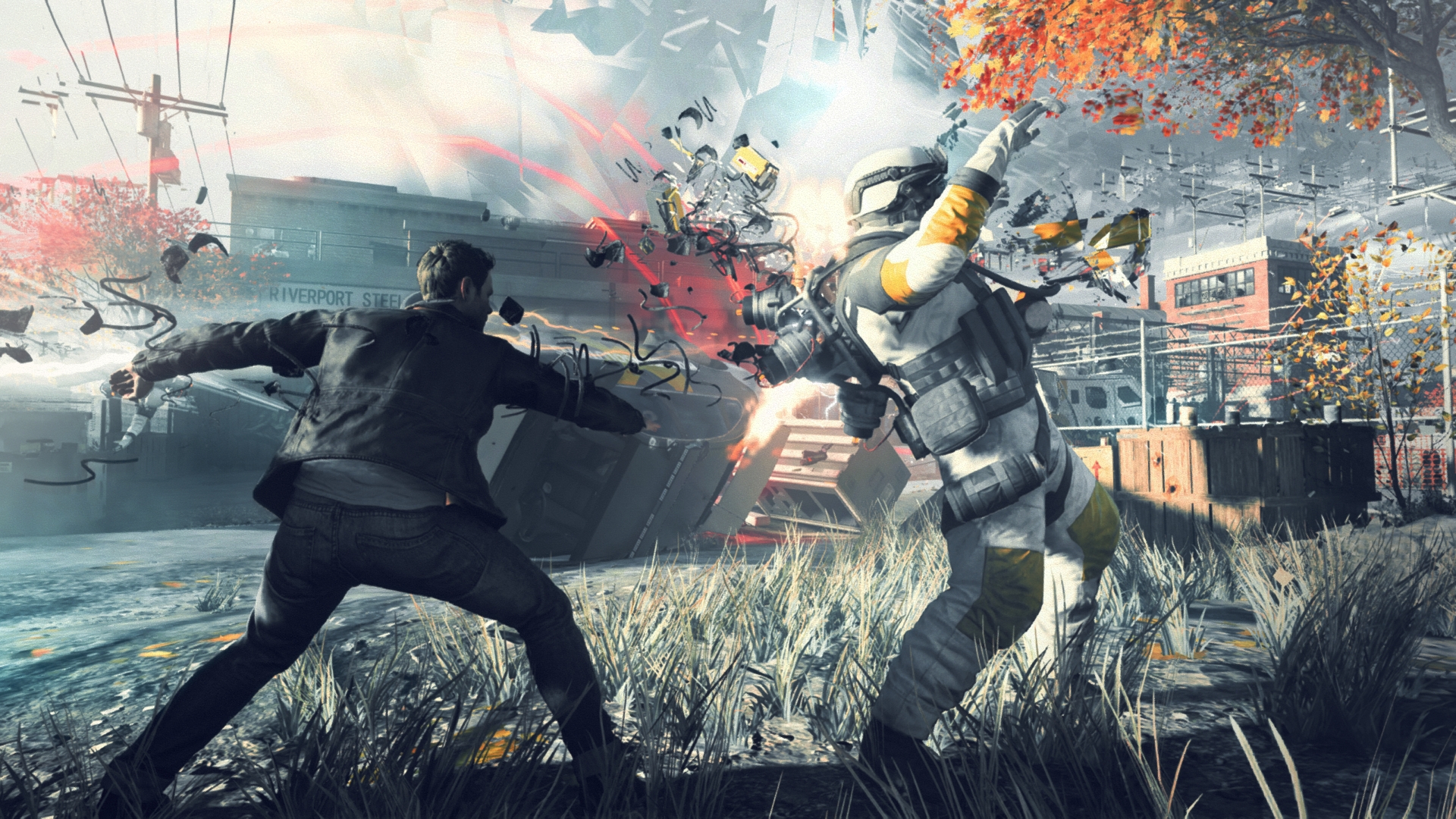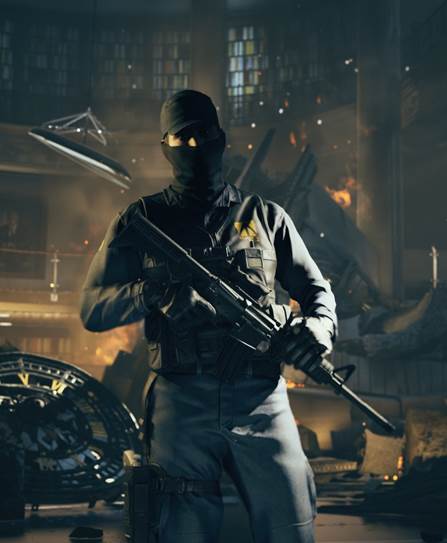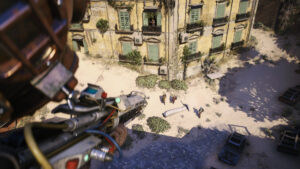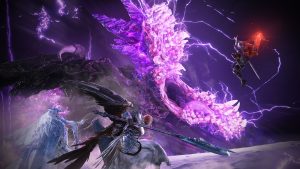
Changing the future by visiting the past creates inexplicable paradoxes. There’s no way for time travel fiction to skirt around this. When crafting Quantum Break’s story – and to handle complex, wishy washy time travel concepts in earnest – Finnish studio Remedy Entertainment consulted real-life physicists, who unsurprisingly posited that travel back in time – as per current understanding – is impossible.
Well… it’s sort of impossible, again based on current understanding. See, theoretically, something as powerful as the gravitational field of a black hole may be enough for people to move backwards in time, but this is pure speculation, and it’s never really explained beyond surface level in Quantum Break, although wannabe tech bro and ultimate antagonist to the story Paul Serene does mention black holes when activating his ill-fated time machine.
Instead of an overly simplistic explanation of space time continuum – think Weir’s pen and folded paper explanation for the Event Horizon’s gravity drive, for instance – Quantum Break relies on schlocky terms such as chronon particles. How does our protagonist gain time bending superpowers? Why, chronon exposure of course. Remedy may as well have said player character Jack Joyce becomes a magician, for all the believability chronon particles offer.
Still, time travel narratives make for engaging, mind-warping stories. And Quantum Break’s portrayal of lifelong friends locked in a time travelling tug of war, each pulling for their opposing perspective, believing their solution to dealing with temporal apocalypse the correct one for mankind, certainly makes for suitable entertainment throughout the game’s campaign. There’re ideological themes of prophecy alongside familial repercussion adding somewhat more grounded elements to the story too. In short, despite the whacky time travelling shenanigans, both Quantum Break’s main characters behave believably with each of their points of view and motivations understandable to players.
What isn’t as easy to understand is Remedy’s decision to marry narrative gameplay with linear storytelling, the latter delivered in four 20-minute blockbuster TV episodes segueing the campaign’s five playable acts, told from the side of the evil overarching Monarch corporation. Was this transmedia delivery a success? Well, depends on who you ask, but consensus amongst reviewer-ship is that Remedy’s attempt to unite two disparate mediums into one entity doesn’t really work. The TV episodes – starring the same ensemble cast as the gameplay sections, albeit in live-action glory – are middling at best. It’s well produced TV for sure, but it’s of the variety that plays in the daytime on those random TV channels that sit somewhere in the middle of TV channel listings, after terrestrial TV but before news and sport. Crucially though, it begs the question of why; why did Remedy feel the need to do this in the first place?
Anyone who’s played a Remedy title will be well used to heaps of endless lore and worldbuilding. The delivery of Quantum Break’s backstory – as complex as it is – is largely done in the same method as their other games. That is, through environmental collectibles – think: corporate emails, wallcharts, audio logs, that sort of thing. It’s an established video game trope but for a narrative dense with tough to understand concepts, it’s arguably a bit of a misstep. Worse still, these collectibles are entirely missable, leading to the very real possibility of playing through Quantum Break without the faintest idea of what the hell is going on.
This decision was presumably taken to avoid overloading players with cutscenes. Who wants to sit through endless cutscenes when they’ve got a 20-minute live action sequence to come after the current action’s chapter concludes? Remedy felt the answer to that question is no-one, hence the questionable delivery of Quantum Break’s story concepts.
This again harkens back to chronon particles and other some-such; Remedy may as well have portrayed Jack and Paul’s time-bending powers as magic because there’s no way they could be sure players will have read every email – some pushing 2,000 words – on every computer they stumble across. Were these concepts delivered in cutscenes or NPC dialogue, or just by means unmissable, perhaps Quantum Break’s time travelling hijinks wouldn’t have seemed so fanciful. Instead, Quantum Break is a disjointed experience, suffering from severe pacing issues hampering what would have been an otherwise enthralling narrative where it not for the 20-minute episodes.
On the flipside, Remedy should be lauded for their ambition. Whilst not an entirely novel concept, fusing multimedia in this way is rarely attempted, but to be fair it hasn’t been attempted since either. Perhaps therein lies the reason for the lack of a Quantum Break successor – it’s simply too complicated to tell this story in the way Remedy wants to. Also, cries from Remedy fans have been unignorably loud for an Alan Wake resurrection – of which 2021’s remaster paved the way for the upcoming Alan Wake 2 – and a sequel to 2019’s telekinetic action-adventure Control, with two follow-on titles in the pipeline, one of which likely a sequel with the other appearing to be some sort of co-operative PvE game set in the Control universe.
Were Quantum Break revisited in a successor though, there’s plenty here to make that follow up worthwhile. Principally, the game’s shooting and time-warping mechanics are oftentimes visceral, exciting, and always entertaining. Jack’s abilities flit between enveloping enemies in stasis bubbles before spraying a shower of air hanging bullets, short distance teleporting to swiftly outmanoeuvre opponents, utilising time shields to hasten the travel of oncoming enemy fire or slowing down time for real granting Jack power to sprint lightning fast between boundaries of opponent heavy arenas. Encounters are fast-paced, with a flow unique amongst third-person shooters once these time shifting abilities are mastered. Of note too, is Remedy’s choice to bestow the player with these superpowers within the first hour of gameplay, so it’s not long before players are combining Jack’s time-stretching abilities in super creative ways on the fly to alter the field of battle. Maybe a sequel could provide deeper power upgrades as the story progresses, as the one drawback to granting an arsenal of superpowers early on is combat encounters can quickly become stale or repetitive.
Exceptional too is Quantum Break’s graphics. Utilising a middleware physics engine known as Digital Molecular Matter Quantum Break elicits eye-popping destruction and deformation effects, superbly selling the notion of a timeline glitching into oblivion. The environment regularly rips and tears apart, with triangular fragments warbling wavelike, pieces of earth and concrete fractured in suspension, recombining both beautifully and haphazardly. Imagine how visually arresting a Quantum Break sequel would be on modern hardware, seeing as it still looks fantastic now despite releasing in 2016 to last generation’s Xbox One.
Again, Remedy should be applauded for their ambition in Quantum Break. It’s a shame all that was good about the game was marred by narrative and structural choices; every element stuffed into the game diluting each other. Is there scope for a sequel? In fact, is there even an appetite for it? Who knows? For now, it appears any notion of a Quantum Break sequel is firmly on the side-lines, what with Remedy’s other projects in the works. Should Quantum Break 2 ever see the light of day, there’s no doubt Remedy will tweak the transmedia formula for the better, it’s just questionable if they’ll ever get round to it.
Note: The views expressed in this article are those of the author and do not necessarily represent the views of, and should not be attributed to, GamingBolt as an organization.

















